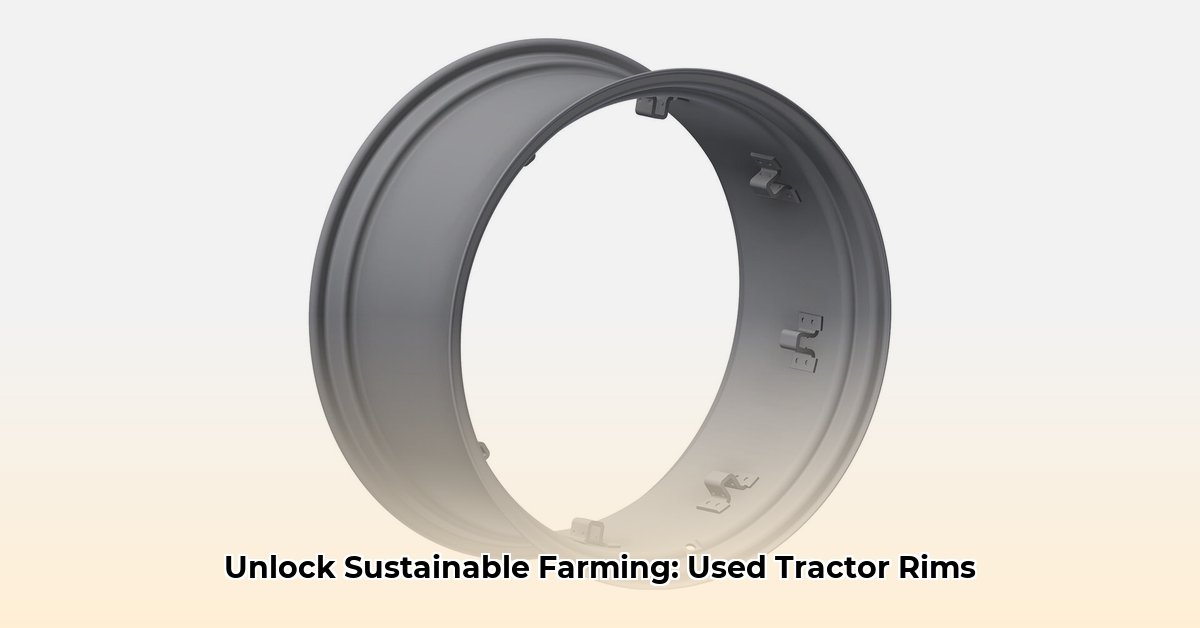
Rim Tractor Sustainability: Your Guide to Used Wheels and Tires
Finding the right rims for your tractor can be expensive. But buying used tractor wheels and tires can save money and benefit the environment. This guide helps you find the best deals on used tractor rims while practicing sustainable farming.
For more options, check out this resource on 26x12 tractor tires.
Understanding Your Needs: Sizing Up Your Rim Tractor
Before searching, determine your tractor's rim size and the type of work those rims will handle (heavy hauling, plowing, etc.). The work and terrain (rocky, muddy) impact rim and tire selection. Understanding these factors prevents wasted time and money. What specific tasks will these tires need to perform, and how will that influence your choices?
Finding Reputable Suppliers: Where to Look for Used Rim Tractor Wheels
Finding a trusted supplier is crucial. Don't settle for the first deal. Check online reviews; ask other farmers for recommendations. Look for companies with good reputations and transparency. Carefully read reviews; note recurring complaints. Paying more for a known quantity is often better than risking damage or unsuitable rims from unreliable sources. How can you verify the trustworthiness of a potential supplier of used tractor rims?
Inspecting Used Rims and Tires: A Thorough Examination
Before buying, thoroughly inspect rims and tires. A damaged wheel can cause accidents or expensive repairs.
Checklist:
- Rims: Check for cracks, bends, or corrosion. Ensure proper tire bead seating.
- Tires: Examine tread depth, cuts, bulges, and sidewall damage. Check for cracking (dry rot). Check tire pressure.
| Component | Detailed Inspection Checklist |
|---|---|
| Tractor Rims | Examine for cracks, bends, rust, or significant corrosion. Carefully check near the bead seat. |
| Tractor Tires | Assess tread depth. Look for cuts, punctures, bulges, uneven wear, and sidewall damage. Inspect for cracks (dry rot). |
Negotiating Prices and Leasing Options: Getting the Best Deal
Negotiate prices. Research market value for a fair price. Don't be afraid to walk away if the price is too high. Leasing is a good option if you need rims temporarily (e.g., harvest season). This reduces initial investment. What strategies can you use to negotiate the best possible price for used tractor rims?
The Environmental Angle: Sustainable Farming Practices
Using used parts is environmentally friendly. Reusing materials reduces demand for new ones, conserving resources and lessening manufacturing's environmental impact. Dispose of worn-out wheels and tires responsibly; find local recycling programs. What percentage of agricultural waste ends up in landfills, and what steps can be taken to reduce this figure?
Long-Term Sustainability: Shaping the Future of Used Parts
Industry standards for used components (e.g., a condition grading system) and transparent material traceability will improve the market's sustainability. Collaboration among farmers and industry groups will create a stronger, more sustainable market. How can increased transparency in the agricultural supply chain promote more sustainable practices?
Government and Industry Responsibility: Collaboration for Sustainability
Government agencies can promote sustainable practices through incentives for recycling, environmental disposal standards, or research funding for sustainable tire and rim materials. Parts suppliers can improve practices through better inventory management, quality control, and sustainably sourced materials. Recycling companies can invest in better recycling technologies and explore new markets for recycled products. This requires collaboration. What policy changes could incentivize the use of recycled materials in the agricultural equipment industry?
Challenges and Solutions: Overcoming Obstacles in the Used Parts Market
Supply chain issues can cause shortages; transporting bulky items can be expensive. Working with multiple suppliers to diversify and planning efficient transport can help manage challenges. What innovative solutions could streamline the logistics of transporting used agricultural equipment parts?
The Advantages of Choosing Used: A Summary of the Benefits
Using used tractor rims and tires offers:
- Cost Savings: Significant cost savings compared to buying new.
- Resource Conservation: Reuses existing materials, reducing environmental impact.
- Reduced Environmental Impact: Reduces energy consumption associated with new product manufacturing.
Sustainable farming involves responsible choices. Choosing quality used tractor rims saves money, protects the environment, and ensures smooth farm operations.
How to Ensure Quality Used Agricultural Tires and Wheels
Key Takeaways:
- Regular inspections are crucial for early damage detection.
- Corrosion-resistant materials extend rim lifespan and reduce waste.
- Proper tire mounting and handling techniques are essential for safety and longevity.
- Preventative maintenance plans minimize costly repairs and downtime.
- Understanding split rim safety protocols is vital for preventing accidents.
- Choosing reputable suppliers is key to acquiring high-quality used parts.
Finding Reliable Suppliers: The Foundation for Quality Used Parts
Finding a reputable supplier is crucial before inspecting used wheels or tires. Ask farmers, use online forums (like TractorByNet), check reviews, and compare prices and offerings from multiple suppliers. Transparency about inventory history and condition is essential. What online resources can farmers use to verify the reputation of suppliers of used agricultural equipment?
Step-by-Step Inspection: What to Look For
A thorough inspection is key to ensuring quality.
- Visual Inspection: Check for dents, cracks, rust, gouges, tread depth, bending, cracks and bolt/nut security.
- Rust and Corrosion: Assess corrosion severity. Severe corrosion compromises structural integrity.
- Tire Condition: Check tread depth, sidewall damage, bulges, wear patterns, cuts, and embedded objects.
- Split Rim Safety (if applicable): Use proper tools and training; improper handling is dangerous.
- Wheel Integrity: Check for looseness or play in wheel bearings (easier with tire removed); compare measurements to manufacturer specs. Significant deflection indicates potential problems.
- Documentation: Review available documentation on service history.
Understanding Costs and Budgeting
Factor in transportation costs, potential repairs, and preventative maintenance when considering budget. Compare this with new equipment costs and expected lifespan. What percentage of the total cost of ownership of a tractor can be attributed to tire and rim replacement?
Preventative Maintenance for Long-Term Value
Regular cleaning, lubrication, and inspections extend the lifespan of used equipment. Proactive maintenance prevents major issues and expenses later. Keeping equipment clean reduces corrosion and rust problems.